Feline Skin Infection
Pyoderma (infection filled wtih pus) or a feline skin infection can occur on any part of a cat's body including the nose, face and skin. Infections tend to be secondary, which means that they are caused by another condition. A common secondary cause is allergy such as cat flea allergy, or cat food allergy. Other causes include an internal disease (hypothyroidism, hyperadrenocorticism), some type of skin gland disease (sebaceous gland problems ,or problem at the hair follicles), parasites (demodex canis causing mange mites) or some problem with a cats anatomy which predisposes the skin to infection such as skin folds."
Feline skin infection can occur in a variety of
forms, including both fungal and bacterial infections. Not every cat
skin disorder is caused by an infection, however; there can be other
causes of cat
skin problems. Infection often occurs when another condition
causes cat skin itch, which causes the cat to scratch and introduce
microbes into the skin, which results in infection. Many
types of infection are also highly contagious and can be passed between
cats.
If a cat has skin folds, or lip folds, this creates warm pockets on the
body which allows above average levels of bacteria to take hold
(colonize) and cause infection.
In general infections are treated with a combination of topical ointments, shampoos, conditioners and topical ointments. Note the ingredients that are required to treat your dog's specific condition and oral medications.
Diagnosis of Feline Skin Infection
The exact underlying cause of a feline skin infection will
need to be diagnosed by
your vet who can best distinguish one cause from another. In some
cases, your vet will be able to diagnose the
infection just by looking at it. In other cases, tests will be needed
in order to determine the exact nature and cause of the infection.
Tests may include examining the affected area under a special
ultraviolet light, taking a swab of any seepage from the area to be
examined under a microscope, and/or blood tests.
If the cat has scratched the skin so much that it has caused the area to develop a bacterial infection. In that case, the skin infection must be treated, but the underlying cause of the itching must also be determined and treated as well.
Treatment for a bacterial or fungal cat skin infection
primarily involves the use of prescription and over the counter topical
treatments as described below. Treatment is often a matter of
trying different products until the patient responds. Cats
with a mild problem can try a combination of an over the counter
medicated shampoo such as ClinicalCare
in addition to the use of a natural remedy described below.
In addition to specific treatments recommended by a veterinarian, the
use of homeopathic skin products could help to reduce the severity of
symptoms and speed healing. These are not a substituted for
specific therapies, but can help improve skin and coat condition. This
includes the use of skin cleaning products such as VPS
Wound Care
which prepares the skin prior to the administration of a topical
medication and topicals designed for specific problems such as Naturasil
for Ringworm. Once healing is under way, skin and coat health
can be supported with a remedy such as Skin
and Coat Tonic.
Feline Bacterial Skin Infection:
Feline skin infection caused by bacterial infection is treated with antibiotics. Minor skin infections are treated with topical antibiotics, while more severe cat skin conditions may require an oral antibiotic. Severe conditions may require 8 to 12 weeks of treatment. Antibiotics used include lincomycin, clindamycin, erythromycin, trimethoprim-sulfamethoxazole, trimethoprim-sulfadiazine, chloramphenicol, cephalosporins, amoxicillin trihydrate-clavulanic acid, or ormetoprim-sulfadimethoxine.
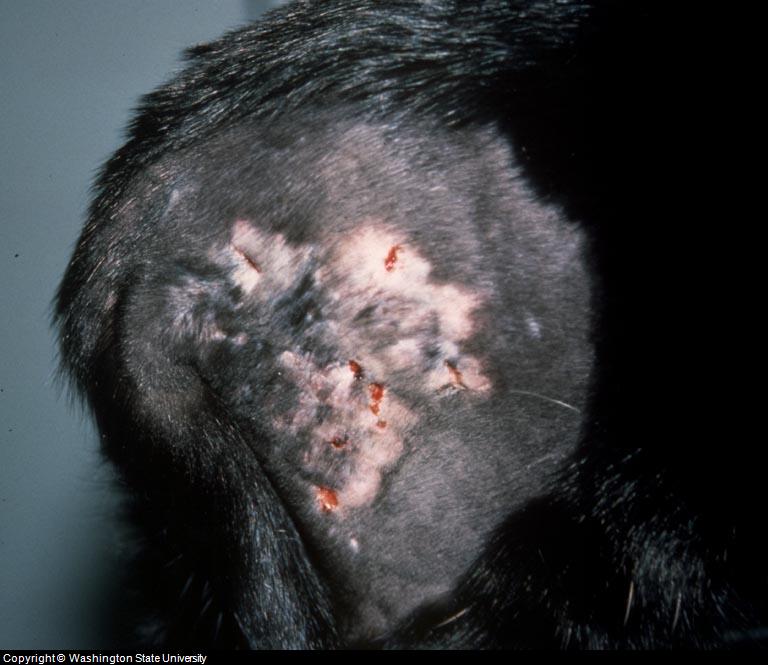
Picture Feline Skin Infection caused by Mycobacterium
Infected areas should be kept clean, with the hair in long haired cats in particular clipped around areas that have deeper infections or puss (pyoderma). A natural cat skin product such as VPS Wound Care can help keep the area as clean as possible during healing.
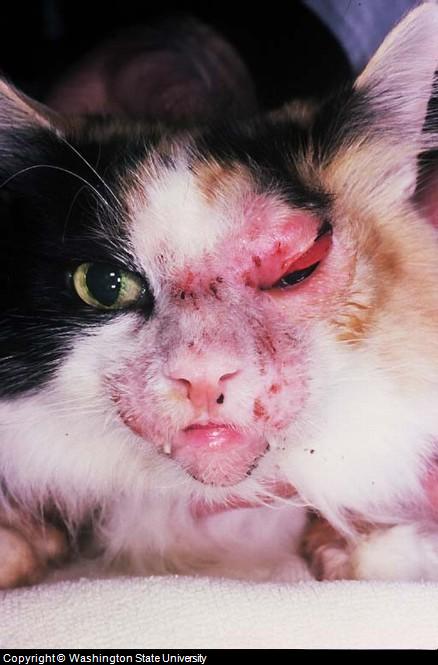
Superficial Bacterial Cat Skin Infection on Face
Feline Fungal Infection
Fungal infection can either be on the surface of
the skin or in the case of skin injury, the fungus has an opportunity
to penetrate further. Microsporum is a type of feline skin
infection cause by fungus that can affect both the skin and hair.
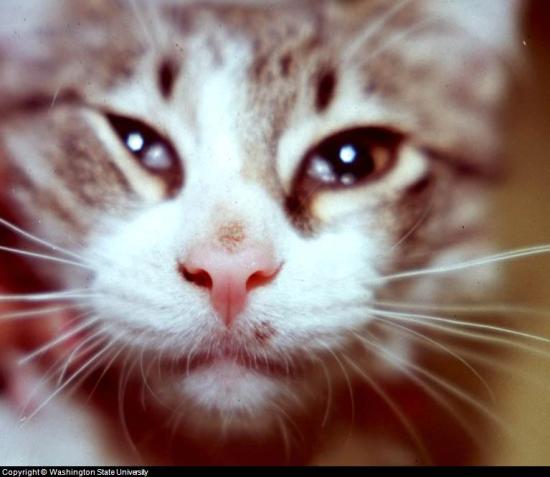
Picture Cat Skin Infection
Picture Cat Nose Infection Caused by Microsporum (fungus)
A veterinarian has a number of topical (applied to the skin) prescription products that can help to eliminate a feline skin infection caused by fungus. These come in many forms including dips, ointments, lotions, sprays and powders. The medication griseofulvin is commonly used. Skin infections that are on the body are often treated with the use of a lime sulfur dip such as Naturasil and/or an anti-fungal shampoo such as ClinicalCare.
Often treatment is experimental, with different products tried
until the condition is brought under control. The reason for
experimentation is that a variety of fungus may be resistant
to the product being used. The goal is trial and
error until a cure is found.
Cat Ringworm (dermatophytosis)
Ringworm is not caused by worms but is a form of skin infection. It is appears as a round red patch with a pale center. It is highly contagious and can be spread between people and cats.
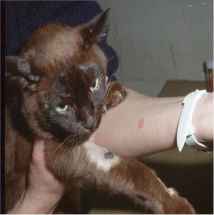
Picture of Cat Ringworm
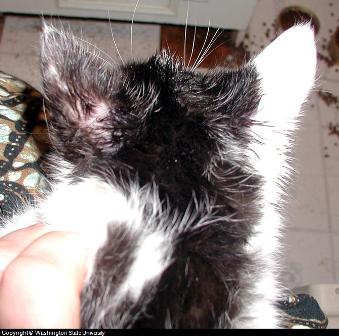
Kitten with Ringworm
Ringworm can be diagnosed with a fungal culture and examination of the culture under the microscope and an examination of the skin under a special light called a "Wood's lamp."
The extent of the fungal infection will determine the best course of treatment. Mild cases will only require some type of topical treatment (treatment applied directly to the skin). More advanced cases require a lime-sulfur dip such as Naturasil for Ringworm. The oral medication Itraconazole is also used. Your cat needs to be soaked in the dip down to the skin. It is considered to be safe and effective.
A treatment pack such as Pet's Best is formulated to cure ringworm treat dry and flaky skin, speed healing and reduce the severity of symptoms. The use of a gentle skin topical to keep the skin clean such as VPS can also be of help prior to the administration of any prescription products.
Your veterinarian will retest your cat after 3 weeks and then again soon after to see if the ringworm has gone away. Treatment usually lasts for a period of 30 days including 2x treatments a week of the dip.
References:
Scott, D. W., Miller, W. H., Griffin, C. E.
Muller and Kirk’s Small Animal Dermatology
Feline Dermatophytosis: Screening, Diagnosis,
Treatment, and Environmental Management
S. Newbury
Koret Shelter Medicine Program
Center for Companion Animal Health
, University of California Davis, Davis, CA, USA
Washington State University College of Veterinary Medicine
Ask Our Vet a Question about a Cat Skin Problem
Do you have a question about a cat skin problem? Share it! We'll pick one question to answer each week for free.
Please let us know about the age of the cat, breed, when any cat skin symptoms began, have they changed over time, if your cat is indoor or outdoor, the presence of other pets, changes in your cats routine, bathing frequency, or anything else that will help us understand your cat's medical history, any tests and results.
If possible, please include a picture. Seeing the skin problem can help us improve suggestions made. Please include information such as breed, age, sex, history, changes in behavior, products used etc.
We will try and respond as quickly as possible. If you have an urgent question we suggest using this online veterinary cat answer service that is staffed by vets and available 24 hours a day. You only pay a small fee for answers you accept.
What Other Visitors Have Asked and Vet Suggestions
Click below to see contributions from other visitors to this page...
Cat Skin Wart 




My cat has this cauliflower looking spot on her back that gets puss. I don't think it's a wart, because it's not hard or dry, but it's starting to bug …
Irritation and Hair Loss Between Cat's Shoulder Blades 




Reader Question: How To Treat A Cat That Has Irritation and Hair Loss Between Its Shoulder Blades?
Vet has not been able to diagnose this. I'm asking …
Treating Fleas on my Indoor Cat Not rated yet
My 5 yr old cat and her "sister" both have more fleas this summer than ever before. I was alarmed at the amount and the small open circles from her biting, …
Cat Licking and Vomiting Not rated yet
Reader Question: What Is Causing My Cat To Keep Licking Itself?
I have a 2 year old cat male. He started licking all over his legs, arms, shoulder …
Round Bare Cat Skin Patches Not rated yet
We've been caring for a male stray cat that arrived at our home. He was starving so we fed him and took him to be neutered.
The clinic that neutered …


